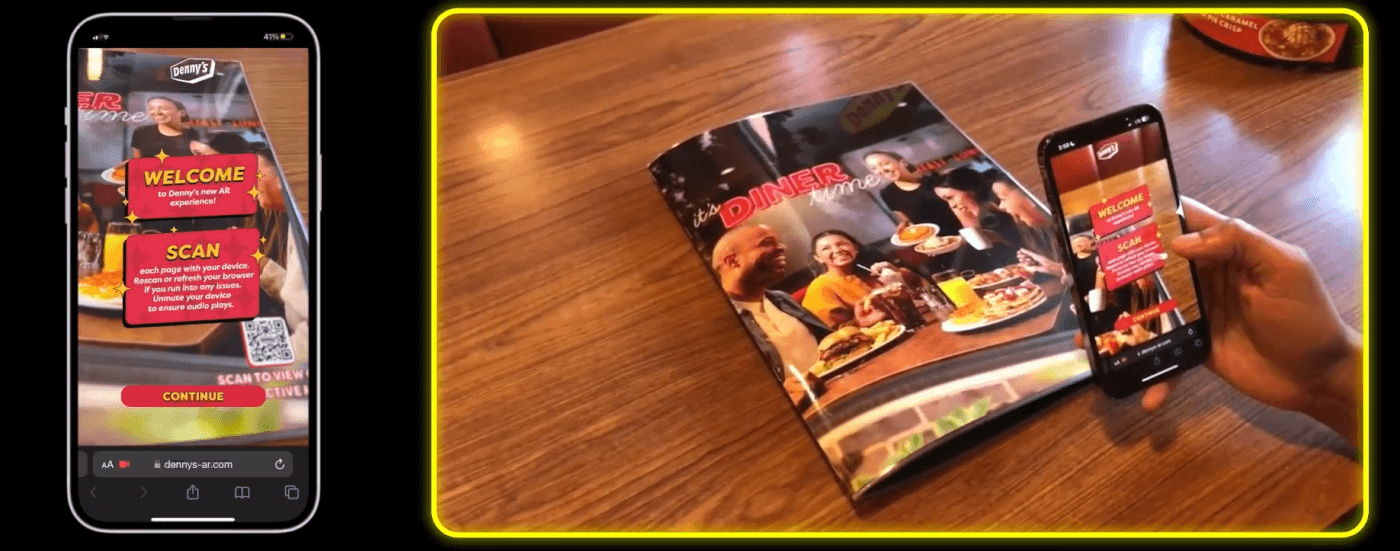While celebrating its 70th anniversary, Denny’s partnered with QReal to produce AR menus where food items seem to leap off its pages. You don’t need to install the restaurant chain’s app on your phone for the AR food menu to work. Just activate your phone’s camera and launch 8th Wall‘s web-based AR platform from your phone’s browser to watch the images come alive.

Denny’s AR Food Menu: What to Expect
With the new AR food menu, you’ll see flames surround the classic Moons Over My Hammy egg sandwich and hear the new Mac N’ Brisket Sizzlin’ Skillet sizzle as it emerges from a barbecue smoker. Also making an appearance is a 3D model of the original diner in 1953—then known as Danny’s Donuts—before becoming the beloved establishment it is today.

Denny’s AR food menu, only accessible when dining at physical outlets across America, is part of Denny’s “It’s Diner Time” brand platform. The campaign also involves the remodeling of its kitchens, the rollout of improved food offerings, and the unveiling of new staff uniforms.
AR Food Menu: Denny’s Latest Foray Into AR
When Denny’s shared its 2022 results in February, CEO Kelli Valade said that one of the company’s strategic priorities is “to lead with technology and innovation.” She also mentioned that “Denny’s is skewing towards younger generations with Millennials and Gen Z currently representing about 45% of our customer base.” So, augmented reality makes perfect sense.
However, this is not the first time the company has tapped into the world of AR. The last time it used this type of computer-generated content was in late 2016 when the diner chain launched its “Shrek the Halls” campaign for the Christmas and New Year holidays. Using the DreamWorks COLOR app, the restaurant’s customers saw characters from Shrek, The Penguins of Madagascar, Puss in Boots, and Turbo Fast arise from the kids’ menus as their phones scanned its pages.
QReal and the Appeal of the AR Food Menu
QReal (formerly Kabaq.io) specializes in creating lifelike, 3D, and AR content for e-commerce platforms and social media campaigns. It works for various industries, from real estate and automotive to fashion and beauty. However, its original passion was food, becoming the first company to make photorealistic AR models of cuisine in 2016 with its KabaQ AR Food Menu app.
“The traditional way people interact with menus is being transformed utilizing [AR and life-like 3D models], leading to an enhanced experience, strong branding, and potentially higher order throughput,” said Mike Cadoux, QReal’s General Manager.
Researchers from several universities who studied QReal’s AR food models attest that such presentations can improve “decision comfort” or “craveability,” spread positive feedback about products, and increase the desire for “higher-value” types of food. Because QReal’s app hardly uses post-production, its users can see their order in advance from different angles in the most realistic way possible.
How the AR Food Menu Will Transform the Restaurant Industry
If we are to believe Cadoux’s forecast, “high-fidelity digital cuisine” will only increase in demand due to its strong potential to boost branding and sales.
Businesses predict that AR food menus will enable customers to order more smartly because AR renders the item’s size and quantity more accurately. Another benefit of such transparency is lower food waste.
Moreover, establishments can use AR to promote new products and enhance engagement with prospects and loyal clientele through behind-the-scenes tours, which can include how they prepare and cook food.




